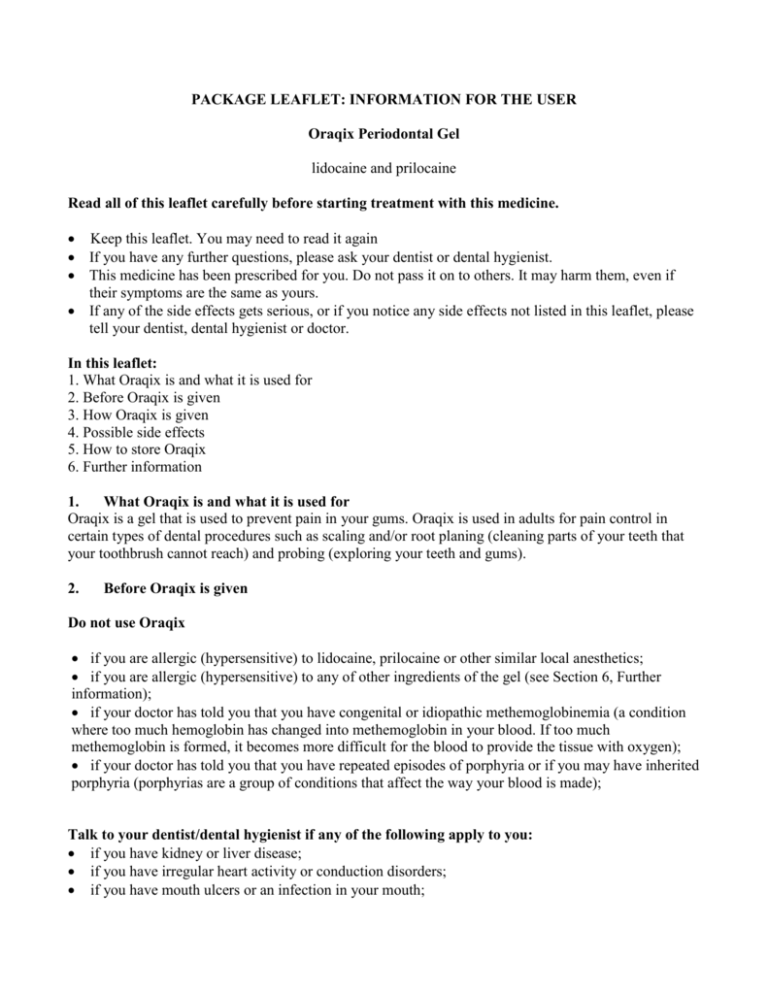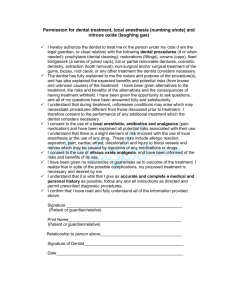Oraqix gel
advertisement

PACKAGE LEAFLET: INFORMATION FOR THE USER Oraqix Periodontal Gel lidocaine and prilocaine Read all of this leaflet carefully before starting treatment with this medicine. Keep this leaflet. You may need to read it again If you have any further questions, please ask your dentist or dental hygienist. This medicine has been prescribed for you. Do not pass it on to others. It may harm them, even if their symptoms are the same as yours. If any of the side effects gets serious, or if you notice any side effects not listed in this leaflet, please tell your dentist, dental hygienist or doctor. In this leaflet: 1. What Oraqix is and what it is used for 2. Before Oraqix is given 3. How Oraqix is given 4. Possible side effects 5. How to store Oraqix 6. Further information 1. What Oraqix is and what it is used for Oraqix is a gel that is used to prevent pain in your gums. Oraqix is used in adults for pain control in certain types of dental procedures such as scaling and/or root planing (cleaning parts of your teeth that your toothbrush cannot reach) and probing (exploring your teeth and gums). 2. Before Oraqix is given Do not use Oraqix if you are allergic (hypersensitive) to lidocaine, prilocaine or other similar local anesthetics; if you are allergic (hypersensitive) to any of other ingredients of the gel (see Section 6, Further information); if your doctor has told you that you have congenital or idiopathic methemoglobinemia (a condition where too much hemoglobin has changed into methemoglobin in your blood. If too much methemoglobin is formed, it becomes more difficult for the blood to provide the tissue with oxygen); if your doctor has told you that you have repeated episodes of porphyria or if you may have inherited porphyria (porphyrias are a group of conditions that affect the way your blood is made); Talk to your dentist/dental hygienist if any of the following apply to you: if you have kidney or liver disease; if you have irregular heart activity or conduction disorders; if you have mouth ulcers or an infection in your mouth; if your doctor has told you that you have glucose-6-phosphate deficiency (an inherited condition that happens when your body lacks the important enzyme glucose-6-phosphate). Take special care with Oraqix The use of Oraqix in children and adolescents has not been assessed and therefore its use is not recommended in persons less than 18 years old. Avoid getting Oraqix into your eyes. If you accidentally get the gel in your eye, the eye must be washed with water or saline solution immediately and protected until you recover feeling in it. Oraqix may occasionally block all feeling in the areas being treated. Try to avoid accidentally biting your mouth. Also, avoid drinking very hot drinks and food until the feeling fully returns. Oraqix may interfere with tests for substances that sportswomen and sportsmen are banned from taking. It may give a false positive reading for these substances. Using other medicines You should tell your dentist if you are taking: any other amide type local anaesthetic or products used to treat irregular heart activity (antiarrhythmics – e.g. mexilitine) since these medicines in combination with Oraqix may increase the risk for the side effects described in section “If you are given more Oraqix than you should have been” other medicines that can cause methemoglobinemia, e.g., certain kinds of antibiotics known as sulphamides. Tell your dentist/dental hygienist if you are taking or have recently taken any other medicines, including medicines obtained without a prescription. Pregnancy and breast-feeding If you are pregnant, thinking of becoming pregnant or breast-feeding, talk to your dentist or dental hygienist before being given Oraqix. Oraqix should not be used in pregnancy unless recommended by your dentist. Breast-feeding can be continued after treatment with Oraqix. Driving and using machines Oraqix has no known effects that should affect your ability to drive or use machines. 3. How Oraqix is given Oraqix will be given by a dentist or dental hygienist. Your dose is decided by the dentist or dental hygienist and will depend on how many teeth need to be treated. Oraqix periodontal gel is intended for use in adults. Oraqix must not be injected. Oraqix gel is applied inside the gum with a dental syringe or by the Oraqix Dispenser and a blunttipped applicator. The maximum dose in a single treatment is 5 cartridges. The full effect is achieved after about half a minute and the dentist or dental hygienist can then start further treatment. The effect should normally last for about 20 minutes. If you feel that the effect of Oraqix is too strong or too weak, tell your dentist or dental hygienist. You may receive other local anesthetics at the same treatment session. Frequent use of large amounts of Oraqix is not recommended. If you are given more Oraqix than you should have been If you are given too much local anesthetic (i.e., Oraqix in combination with another anesthetic), the following side effects may occur: numbness of the lips and around the mouth, nervousness, lightheadedness, dizziness, shakiness, or sometimes blurred vision, drowsiness, and loss of consciousness. Other rare effects are fits, breathlessness, and lowered blood pressure. Too much prilocaine (Oraqix in combination with another anesthetic containing prilocaine) may also cause methemoglobinemia (see Section 2). This is characterised by slate-grey cyanosis (a bluish-grey discoloration of the lips and the skin). If you have any of the above symptoms, contact your dentist, dental hygienist or doctor, go to the emergency department of your nearest hospital for assessment of the risk and advice. You may need to be watched for several hours. 4. Possible side effects Like all medicines, Oraqix can cause side effects, although not everybody gets them. Common side effects (affecting up to 1 in 10 people) headache changes in taste reactions in mouth (pain, soreness, numbness of other parts of the mouth or lips, ulcer, irritation and redness) Uncommon side effects (affecting less than 1 in 100 people) allergic reactions which could include: skin rash, swelling of the throat, breathing difficulties and fever dizziness feeling sick breathing difficulties and cyanosis (a bluish-grey discoloration of the lips and the skin). burning sensation swelling at site of application Overdose of Oraqix could result in central nervous system excitation or depression and depression of cardiac conduction and function of the heart. In the event of any concern relating to these possible side effects you should be taken straight to the hospital. If any side effect gets serious, for example you have breathing difficulties or swelling of the throat or there is suspicion of an anaphylactic reaction to the anaesthetic, tell your dentist or doctor immediately or go straight to the hospital. If you notice any side effects not listed in this leaflet, please contact your dentist or dental hygienist while still in the surgery or your doctor if you have returned home when these occur. 5. How to store Oraqix Keep out of the sight and reach of children. Do not freeze. Do not use Oraqix after the expiry date printed on the carton. The expiry date refers to the last day of that month. Medicines should not be disposed of via wastewater or household waste. Ask the pharmacist how to dispose of medicines no longer required. These measures will help protect the environment. 6. Further information What Oraqix contains The active substances are prilocaine (base) and lidocaine (base). The other ingredients are poloxamer 188 purified, poloxamer 407 purified, purified water, and dilute hydrochloric acid, used to adjust pH. What Oraqix looks like and the contents of the pack Oraqix is a Periodontal gel. It is a clear, colorless gel in a glass cartridge for and is single use. Each gram of Oraqix periodontal gel contains 25 mg of lidocaine and 25 mg of prilocaine. Each cartridge contains 1.7 g of gel (42.5 mg lidocaine and 42.5 mg prilocaine). Each pack contains 20 cartridges. Marketing Authorisation Holder DENTSPLY Limited, Building 3, The Heights, Weybridge, Surrey, KT13 0NY United Kingdom Medical Information Department Telephone: ++44 (0) 1932 837279 Alternate Telephone: ++44 (0) 1932 853422 Fax: ++44 (0) 1932 857135 Email: enquiry@dentsply-gb.com Manufacturer Recipharm Karlskoga AB, Björkbornsvägen 5, SE-691 33 Karlskoga Sweden This medicinal product is authorised in the Member States of the EEA under the following names: NAME OF THE MEMBER STATE Austria Denmark Finland Germany Iceland Netherlands Norway Sweden Belgium Luxembourg Ireland NAME OF THE MEDICINAL PRODUCT Oraqix Periodontal Gel lidocaine, prilocaine Oraqix 25/25 mg Gel Periodontal lidocaine, prilocaine Oraqix 25/25 mg per g Periodontal Gel UK France Portugal Spain Italy lidocaine, prilocaine Oraqix Gel Periodontal lidocaine, prilocaine Oraqix 25/25 mg/g Gel Periodontal lidocaine, prilocaine This package leaflet was last approved on February 28, 2014. Tear off ………………………………………………………………………………………… The following information is intended for medical or healthcare professionals only: For full information about the use of Oraqix, please refer to the Summary of Product Characteristics (SmPC). Method of administration Oraqix must not be injected On average, one cartridge (1.7 g) or less Oraqix will be sufficient for one quadrant of the dentition. The maximum recommended dose of Oraqix at one treatment session is five cartridges, i.e., 8.5 g gel containing 212.5 mg lidocaine base and 212.5 mg prilocaine base. When administered, Oraqix must be a liquid. If it has formed a gel, it must be placed in a refrigerator until it becomes a liquid again. The air bubble visible in the cartridge will move if the cartridge is tilted. The gel may become opaque at temperatures below 5°C. The gel will return to the original appearance after warming up to room temperature. Oraqix is a gel after administration. The cartridge and applicator are intended for single use. They fit into the Oraqix Dispenser. Fill the periodontal pockets with Oraqix gel by means of a dental syringe or the Oraqix Dispenser and the blunt-tipped applicator included with the pack, until the gel becomes visible at the gingival margin. Wait half a minute before starting treatment (a longer waiting time does not enhance the anesthesia). The duration of anesthesia, as assessed by probing of pocket depths, is about 20 minutes. If the anesthesia starts to wear off, re-apply Oraqix as needed. If additional local anesthesia is needed in combination with Oraqix, please refer to the specific SmPC of each adjunctive anesthetic. Because the systemic toxic effects are additive (see section 4.5 and 4.9 of the Oraqix SmPC), it is not recommended to give any further local anesthetics at the same treatment session if the amount of Oraqix administered corresponds to the maximum recommended dose of five cartridges. Avoid contact with Oraqix to prevent the development of possible allergy.






